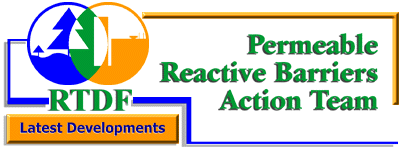 |
|
||||||
|
|
|
||||||
|
|
|||||||
 |
|
||||||
|
|
|
||||||
|
|
|||||||
|
Installation Date: Contaminants: Reactive Media: Cost: Construction: Point of Contact: |
|
|
A full-scale permeable reactive barrier (PRB) was installed as an Interim Remedial Action (IRA) at F.E. Warren Air Force Base Spill Site 7 in Cheyenne, WY in 1999. The construction contractor chose a trench box system because of subsurface conditions and requirements for tracking iron usage. Trichloroethylene (TCE), cis-dichloroethylene (cis-DCE), and vinyl chloride (VC) are the contaminants of concern at the site. Initial concentrations encountered at the site were 21,000 µg/L for TCE, 5,600 µg/L for cis-DCE, and 120 µg/L for VC. Spill Site 7 is an area where waste solvents associated with liquid oxygen production were discharged to a surface drainage ditch and infiltrated to ground water at depths of 8-20 ft. The heterogeneous aquifer and geotechnical properties complicated the placement and composition of the PRB. The existing infrastructure on the site and the rare and endangered species area down gradient of the site added further limitations to the placement of the PRB. There is a 4-ft ground-water elevation fluctuation and no well-defined confining layer. Hydraulic conductivity varies from 0.01-4 ft/day. The PRB consists of 3 segments, each 4 ft wide and ranging in length from 155-251 ft, a total of 568 ft long. Each segment contains a different mix and thickness of reactive media depending on the ground-water velocity and level of contaminants. One segment consists of pure iron filings, another a 25/75% mix of iron and sand, and the third a 37.5/62.5% mix of iron and sand. The vertical depth of the PRB is 15 ft, while the depth below ground surface ranges from 6-24 ft. Installation costs including materials, construction, oversight, and the technology licensing fee totaled approximately $2.4 million. Design costs were approximately $217,000.
Successful PRB designs often require extensive site characterization in the pre-design phase. Successful installations require effective site layout, construction sequence, and heavy equipment selection. Construction methods must be flexible enough to be modified to accommodate unforseen conditions. A complete understanding of the characteristics and behavior of backfill material is important. |
![]()
Sponsored by the Technology Innovation Program
Date Last Modified: May 31, 2001